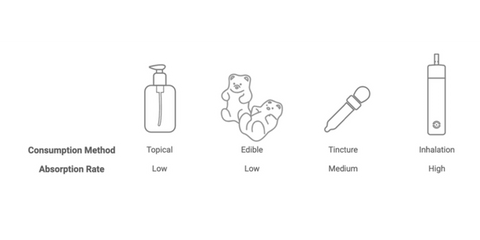Since the 2018 Farm Bill officially legalized hemp and hemp-derived CBD on a federal level, we’ve seen the cannabinoid explode in popularity. The formerly niche cannabis compound is now showing up in dog treats, beauty products, and on the shelves of your local pharmacy. Now that CBD is more widely available, many people who’ve never even considered using cannabis before are becoming regular CBD consumers.
However, some new customers are questioning if their CBD is doing anything at all. If you’ve been taking certified lab-tested CBD with little to no effect, the issue could be bioavailability.
What Is Bioavailability?
Bioavailability is a way of measuring the proportion of a particular drug that is able to reach the human’s circulatory system and therefore produce effects. CBD doesn’t typically have high bioavailability when compared to other supplements or drugs, though there are different administration methods that are more effective than others.
CBD Oral Bioavailability

These days, it’s incredibly common for people to consume CBD orally. CBD capsules make it easy to incorporate the cannabinoid into your daily supplement routine, and tasty confections like CBD gummies add a touch of sweetness to your day. There are even CBD-infused beverages you can enjoy on a hot summer day.
While these edible CBD products do offer a convenience factor, you end up sacrificing a good deal of the effects. That’s because orally administered CBD has the lowest bioavailability of any administration method.
When you take a CBD edible, it first has to navigate the body’s labyrinthian digestive system before it can be absorbed into the bloodstream. During this arduous journey, much of the CBD ends up going to waste. So say, for example, you’ve taken a 20 mg CBD gummy; only around 3 mg of that CBD will end up being metabolized by the liver and having an effect. If you’ve been taking CBD edibles and haven’t felt much of an effect, it is very likely you’ve been under-dosing due to its low bioavailability.
CBD Sublingual Bioavailability

Another very popular method for consuming CBD is by using a CBD oil or tincture. Some choose to simply add CBD oil into a beverage, making it (essentially) an edible. However, most tinctures are also designed to be used sublingually.
For those who don’t know, sublingual administration refers to applying a compound under the tongue for a period of around thirty seconds to one minute so that it can be directly absorbed into the tissues and salivatory glands found inside the mouth.
Since the sublingual method circumvents the digestive tract, it has a significantly higher bioavailability than edibles. Still, there is an even more efficient administration method.
CBD Inhalation Bioavailability
By far, the most efficient way to consume any cannabinoid is by inhaling it. Inhalation methods include things like traditional smoking à la joint or bong, vaporizers, and novel devices like cannabinoid inhalers. Not only does using an inhalation method increase bioavailability, meaning you need a lower dose for a stronger effect, it also brings those effects on faster. Despite not yet being approved by the FDA, many people choose to use CBD to help treat their pain. For these pain patients, it’s essential that they can access the therapeutic benefits of CBD when they’re having a flare-up and not in the hour to two hours it takes for an edible to kick in. Fast-acting effects also help users find the dose that’s right for them more easily.
The elon®, E1011 Labs’ innovative new CBD delivery device, allows users to maximize CBD’s bioavailability without sacrificing the benefits of all-natural flower. The elon®’s patented concentric heating technology gently raises the temperature of CBD-rich hemp flower to the ideal level for vapor production without reaching the point of combustion. According to researchers, this lower temperature heating element significantly reduces the risk to lung health that typically comes with conventional smoking.




